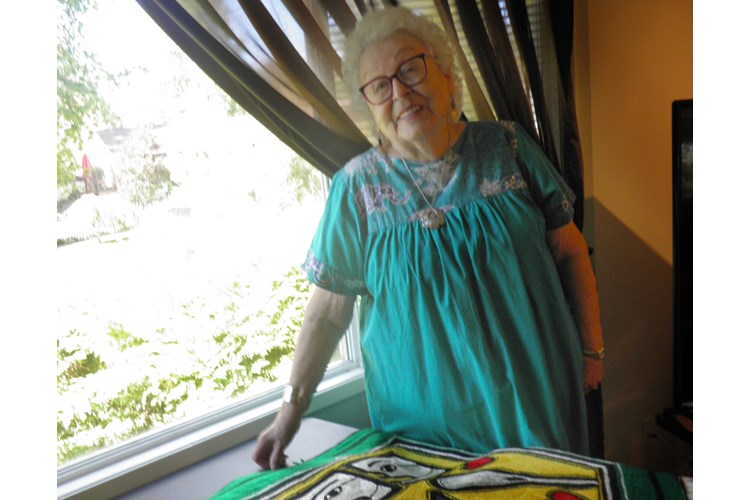When Marion Hunt-Doig makes a Chilkoot blanket it takes an average of two years. Except for the last one she made. That one she started when she was 83 and just finished at 88. Apparently, it was her beloved husband’s fault. Fred Doig died on her in 2019 and for a while she thought she could not keep going. Her children and grandchildren wouldn’t let her go. She fell in the back yard and the neighbour’s dog Rex made such a fuss about it that they found her and got her to the hospital. All her doctors kept at her, and she got better and now she feels strong again. Fred will have to wait a while. Now that she has finished grandson Drew’s blanket, she started one for her sister. Two more years.
Drew’s Chilkoot blanket tells people who he is and where he comes from. The faces across the top represent Marion’s father and her four brothers. It has Marion and Fred’s hands. She used an outline of Drew’s hands from when he was 18 months. He is 32 now. There are lacrosse sticks for his father Brett and grandpa Fred. The eel grass (atsayam) symbolizes the Indigenous grandmothers that taught Marion. The hearts are for his Portuguese grandparents. They follow their traditions, just like Marion and Fred.
“When I was a little girl, my grandmother would take me out on the ocean at low tide to harvest the eel grass, the atsayam. She would put her oar in and twist it around. When she brought it up it looked like green onions! She just bit the top off, peeled it like an onion, swished it off and told me to open my mouth,” Marion said with a laugh. “Since then, there has been a lot of pollution and we can’t eat it anymore, so the young people aren’t learning that word. It’s going to disappear.”
Those two grandmothers taught her how to make the blankets, how to cook, without her ever realizing she was learning. When she started her workshops for blanket making, she followed that example and started her classes by saying, ‘I am your Indian grandmother.’
Marion has made 15 Chilkoot blankets and over a hundred button blankets. When Marion travelled for her school program, she would take a Chilkoot blanket to keep herself busy. In Chicago she taught young boys in a private school how to make button blankets. Those button blankets also tell the story of who you are and where you come from.
When Marion started her program, she was a west coast Kwaquith in Lhiedli T’enneh territory and couldn’t get funding because she wasn’t where she belonged. So, she started on her own with Fred’s assistance.
“I got the Governor General’s award and the Woman of Distinction award.” Marion said with a giggle. “It didn’t say Indian or Native, just cultural. I got it into the mainstream! I liked that.”
Marion grew up on the reserve near Alert Bay. As a child she lived outside, roaming freely, visiting anyone’s campfire when she got hungry. That freedom didn’t end until the day school started. School isn’t a good memory because she didn’t speak English and she didn’t understand the rules. She and her older brother were always in trouble. But they learned English.
“I can still speak my language, better than English sometimes. When you translate what I am saying to English, you can say it 10 different ways. You see that when you listen to politicians,” she said with a mischievous smile. “When we say something, there is just one way to say it.”
Her father was disappointed when she and her three sisters married white men. No children with dark hair with a widow’s peak and lovely dark eyes, and she moved so far away. Marion taught her blond nephews to dance for the potlatches. Then her father was so proud.
“I’ve had fun all my life. All these kids kept coming. Fred and I had so much fun!”
Marion is a bridge between cultures with a big welcoming smile. The Pierreroys say that Marion is an adopted elder now. They and her other neighbours – and Rex the dog—keep an eye on her and help her feel safe when her family isn’t there.



